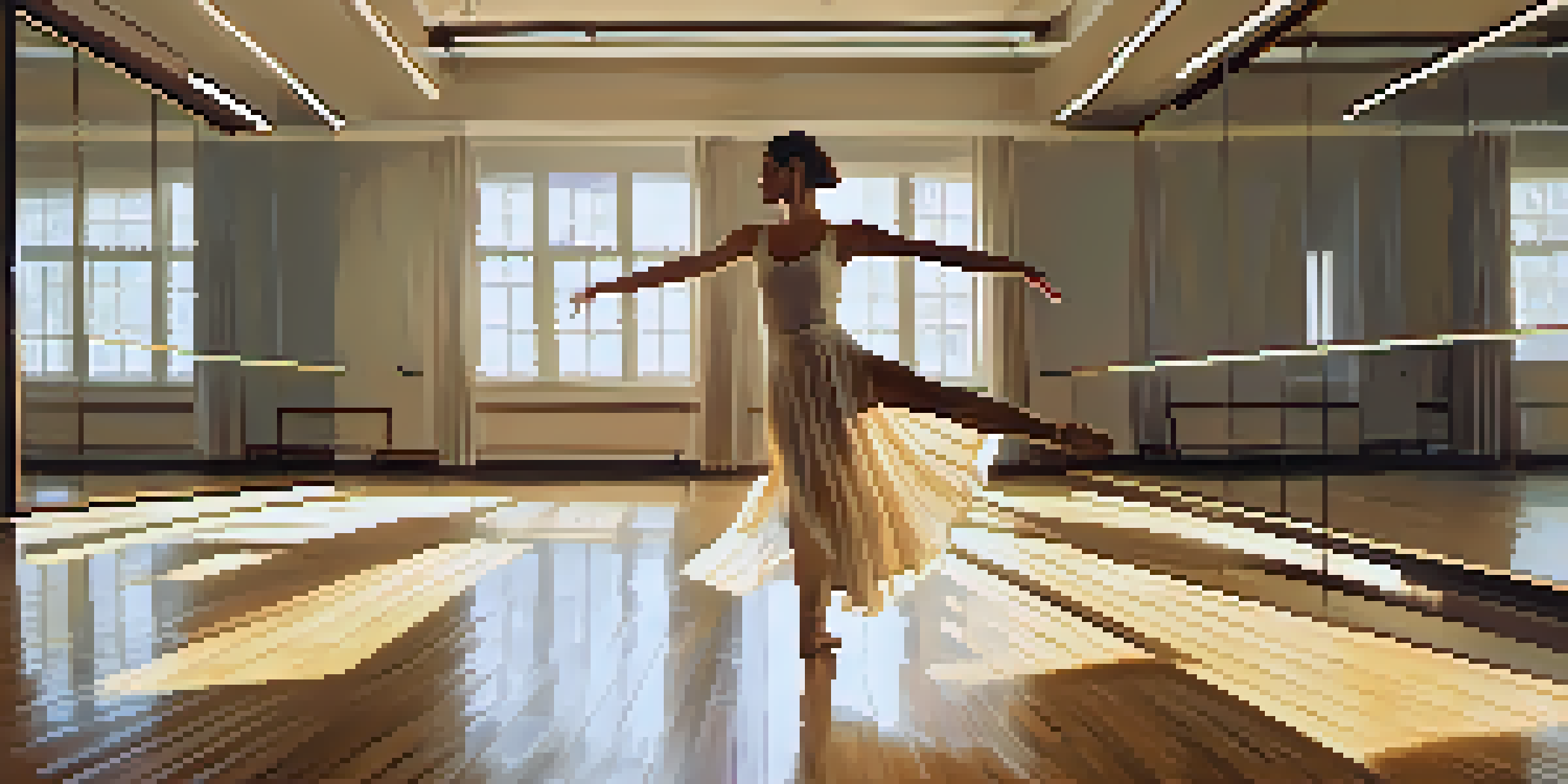Dance Techniques That Promote Emotional Regulation and Growth

Understanding Emotional Regulation Through Dance
Emotional regulation refers to our ability to manage and respond to our emotions effectively. Dance, as a form of expression, allows individuals to channel their feelings creatively, providing an outlet for both joy and sadness. By engaging in dance, one can develop a deeper awareness of their emotions, which is the first step towards regulating them.
Dance is the hidden language of the soul.
For instance, a dancer might use fluid movements to express calmness or sharp, quick steps to showcase anger. This physical representation of feelings can help individuals recognize their emotional states in a safe environment. Thus, dance becomes a mirror reflecting our internal world, allowing for greater emotional insight.
Moreover, participating in dance classes or workshops can foster a sense of community and support. Sharing experiences with others creates a safe space for emotional exploration, enhancing the overall experience of emotional regulation through dance.
The Role of Rhythm in Emotional Expression
Rhythm plays a crucial role in dance, acting as a heartbeat that guides movement and expression. Engaging with rhythmic patterns can help individuals connect with their emotions on a deeper level. For example, slow, steady beats might evoke feelings of tranquility, while fast, erratic rhythms can stir excitement or anxiety.

When dancers synchronize their movements with music, they often find that the rhythm resonates with their emotional state. This connection can lead to cathartic releases, where individuals let go of pent-up feelings through movement. By allowing the rhythm to guide them, dancers can achieve a flow state that enhances emotional clarity.
Dance as Emotional Expression
Dance provides a creative outlet for individuals to channel and manage their emotions effectively.
Furthermore, exploring different genres of music and their associated rhythms can expand emotional expression. Whether it’s the smooth jazz of a waltz or the energetic beats of hip-hop, each style offers unique opportunities for dancers to explore various facets of their emotions.
Improvisation: A Path to Self-Discovery
Improvisation in dance encourages spontaneity and creativity, making it a powerful tool for emotional growth. When dancers let go of structured choreography, they open themselves up to genuine self-expression. This freedom allows individuals to explore and communicate their feelings without the constraints of predefined steps.
The body says what words cannot.
For instance, a dancer might feel inspired to create movements that reflect their current mood, whether it's joy, sadness, or even frustration. This exploration can lead to profound self-discovery as they uncover hidden emotions or desires. Improvisation serves as a conversation between the body and the mind, fostering a deeper connection to oneself.
Additionally, improvisational dance can help individuals confront and release emotions that may have been suppressed. By engaging in this practice, dancers often find themselves experiencing a sense of relief and clarity, paving the way for personal growth and enhanced emotional resilience.
Mindfulness and Dance: Finding Presence in Movement
Incorporating mindfulness into dance can significantly enhance emotional regulation. Mindfulness involves being present and fully engaged in the moment, which can be achieved through focused movement and awareness of breath. When dancers practice mindfulness, they learn to observe their thoughts and feelings without judgment, leading to greater emotional clarity.
For example, during a dance session, taking moments to pause and connect with one’s breath can ground the dancer, creating a sense of calm amidst the movement. This practice helps individuals recognize their emotional responses as they arise, allowing for more intentional choices in how they express those feelings through dance.
Rhythm Connects Emotions
Engaging with rhythmic patterns in dance helps individuals resonate with and express their emotional states.
Moreover, cultivating mindfulness through dance can lead to a greater appreciation for the body and its capabilities. Dancers become attuned to their physical sensations and emotions, fostering a holistic understanding of their well-being and promoting emotional regulation.
Dance Therapy: A Professional Approach
Dance therapy is a specialized field that uses movement to promote emotional, cognitive, and physical integration. Guided by a trained therapist, individuals engage in dance to explore their emotions and experiences in a safe and supportive environment. This therapeutic approach can be particularly beneficial for those struggling with mental health issues, trauma, or emotional regulation.
During a dance therapy session, participants might engage in various activities, from improvisation to structured movements, tailored to their emotional needs. The therapist provides guidance and support, helping individuals to process their feelings and experiences through movement. This not only aids in emotional regulation but also fosters personal growth.
Additionally, dance therapy emphasizes the importance of creativity as a healing tool. By allowing individuals to express themselves through dance, therapists can facilitate breakthroughs in emotional understanding and regulation, ultimately leading to transformative personal growth.
Building Confidence Through Dance Techniques
Confidence is a key component of emotional regulation, and dance techniques can significantly enhance self-esteem. Learning and mastering dance skills, whether basic steps or complex routines, provides a sense of accomplishment that can boost one’s confidence. As individuals grow more comfortable in their movements, they often become more at ease with themselves.
For instance, participating in group dance classes can foster a sense of belonging and support. Sharing the dance floor with others encourages collaboration and positive reinforcement, which can amplify feelings of self-worth. This social aspect of dance can create a nurturing environment for individuals to explore their emotions freely.
Improvisation Fosters Self-Discovery
Improvisational dance encourages spontaneity, leading to genuine self-expression and deeper emotional insights.
Moreover, the act of performing, whether in front of an audience or in a casual setting, can further solidify confidence. As dancers express themselves through movement, they learn to embrace vulnerability, which ultimately strengthens their emotional resilience and personal growth.
Creating a Personal Dance Practice for Emotional Growth
Establishing a personal dance practice can be a powerful way to foster emotional regulation and growth. By dedicating time to dance regularly, individuals can create a routine that encourages self-expression and emotional exploration. This practice can be tailored to one’s preferences, whether it's freestyle dancing at home or attending classes.
For those who might feel unsure about where to start, setting aside a few minutes each day to dance freely can be a great introduction. This encourages individuals to connect with their emotions and release any pent-up feelings through movement. Over time, this practice can become a cherished ritual that supports emotional well-being.

Additionally, keeping a dance journal can complement this personal practice. Documenting feelings before and after dance sessions can provide insights into emotional patterns and growth, allowing individuals to track their progress and celebrate their journey toward emotional regulation and self-discovery.